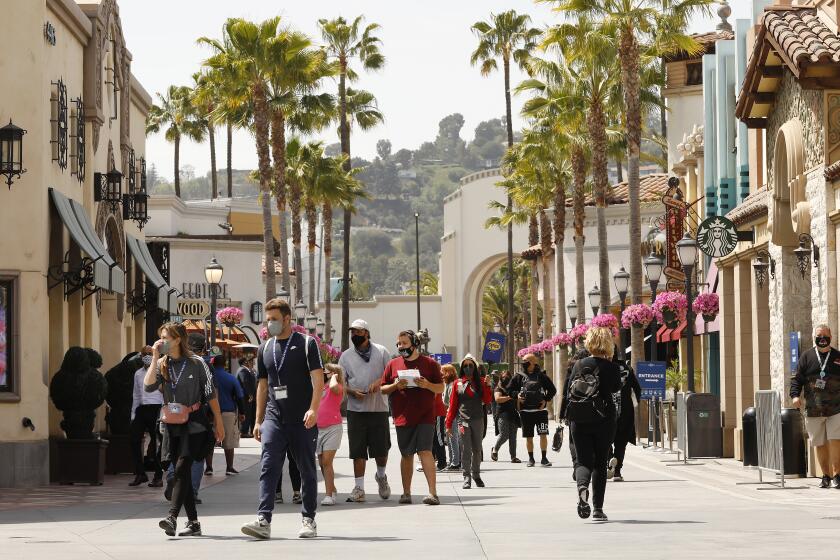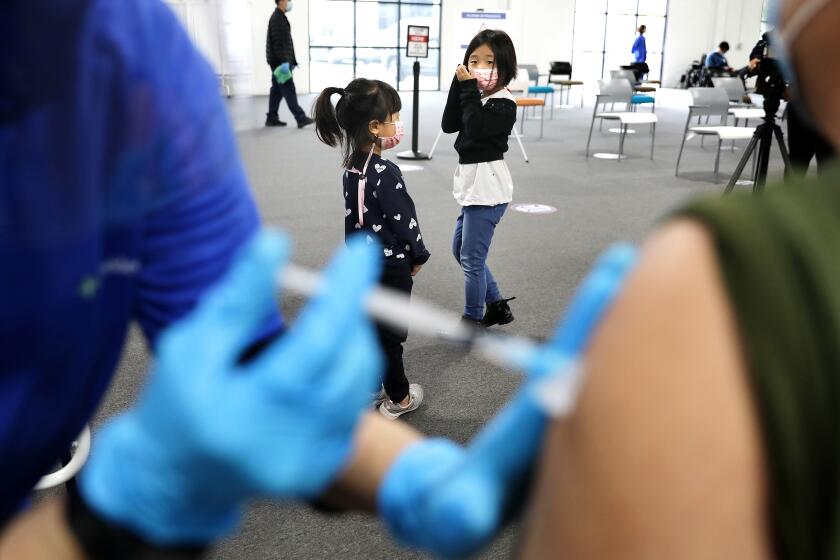People are still dying from COVID in California despite huge progress. Here’s who they are
- Share via
Claudio Arturo Diaz had a lot to celebrate when he turned 64 in February.
A beloved husband, father and grandfather who worked four essential jobs, he was now only one year away from his planned retirement.
But just hours after he delighted his family with his rendition of the Beatles’ “When I’m Sixty-Four,” Diaz began to feel ill. He was diagnosed with COVID-19 and, within a month, was hospitalized and placed on a ventilator.
He died in San Rafael on Easter Sunday, April 4 — three days after all Californians ages 50 to 64 became eligible for the COVID-19 vaccine.
Despite a statewide mood of optimism as more people get vaccinated and case rates improve, an average of 57 Californians a day are still succumbing to COVID-19. An average of about 12 of those daily deaths are in Los Angeles County, according to data from the last seven days.
On the one hand, that’s a huge cause for celebration. During the worst days of the pandemic, California was seeing an average of nearly 600 people a day dying. But the sharp drop in deaths also raises a question: Who is still dying and why?
And for families losing loved ones today, the usual pain of loss is compounded by its arrival at a time when the death rate is plummeting.
“It’s so unfair,” said Diaz’s daughter, Lin-Yu Diaz, 36. “Now we’re getting phone calls about setting up the vaccination, but it’s too late.”
Moving into the yellow tier clears the way for Los Angeles County to unshackle its economy to the widest extent currently allowed.
Latino populations have been disproportionately affected by the pandemic, and they continue to account for a high number of deaths, though fewer proportionately: For the two-week period ending May 9, about 40% of the people who died of COVID-19 in California were white and 34% were Latino, according to state data. About 10% were Asian, 7% were Black, and 9% were multiracial or other.
And as in earlier stages of the pandemic, most of those who recently died of COVID-19 — about 59% — were men.
Dr. Brad Spellberg, chief medical officer at Los Angeles County-USC Medical Center, said many of those who recently died were people like Diaz who became sick months ago, when the infection rate was high and vaccines weren’t widely available.
“These deaths are likely people that were infected in January and February,” he said, noting that the dying process can take that long.
Last week, L.A. County-USC — the largest public hospital in the Western United States — had only 21 COVID-19 patients, Spellberg said, down from a peak of about 275 during the devastating autumn-and-winter surge. Notably, only one of the current patients was admitted for COVID-19. The rest came in for other reasons and found out they were positive through the hospital’s routine testing.
“All the symptomatic patients we’re seeing now have mild symptoms,” Spellberg said. “They have a cold, they have the flu, they have a slight illness. ... I don’t think we’ve had a COVID admission to the ICU in probably at least six weeks.”
Those sunny statistics can make it even harder for the small group of Californians suffering the loss of loved ones right now.
Guilt, shame and heartbreak
At Martin Luther King Jr. Community Hospital in South L.A., formerly an hot spot of the pandemic, only eight of the 169 patients admitted the last week of April tested positive for the coronavirus, according to figures provided by the hospital.
The hospital’s chaplain, the Rev. Rudy Rubio, said some of the COVID-19 patients and families who remain are coping with feelings of guilt or shame on top of their heartbreak.
“I think there was a lot more support when [the surge] was happening because it was such a real thing all over the place, and everybody in some way, shape or form had experienced the collateral damage,” he said.
The family of one recently admitted patient, who was on a ventilator and unlikely to survive, told Rubio that they had “let their guard down.”
“A lot of people thought we’d gotten past this and were celebrating, and this is probably how this family member of theirs contracted it,” he said.
In California, age also remains a factor in COVID-19 deaths. For the two-week period ending May 9,about 72% of the state’s residents who died were 65 or older, while 20% were between the ages of 50 and 64. Only 8% were between the ages of 18 and 49, and none was younger than 18. The numbers reflect those seen throughout the course of the pandemic.
Skilled nursing homes and assisted living facilities, formerly hotbeds for COVID-19 outbreaks, are seeing case rates improve as more seniors get vaccinated. Of 45,000 coronavirus tests administered in L.A. County’s skilled nursing facilities the week of April 17, only 26 came back positive, according to the county’s Public Health Department. By comparison, there were 2,532 positive tests the week of Dec. 28.
But some recent deaths date back to when care facilities simply couldn’t immunize residents fast enough. In Huntington Beach, assisted living resident Dolores Cracchiolo, 90, was diagnosed with COVID-19 on Christmas day, the same week she was supposed to receive her first vaccine dose. She died March 24.
“She wasn’t like everybody else’s grandma,” her granddaughter, Deanne Mendoza, 43, recalled. “She was young and energetic and adorable, and you could always borrow clothes from her closet.”
The family struggled with being separated from Cracchiolo during the pandemic, and often visited her through the window of her living facility. Originally from Detroit, she had fallen in love with Southern California as a young woman and spent decades building a life rich with children, grandchildren and cousins in the area.
And although Mendoza said she is happy to see the state reopening — and believes her grandmother would be, too — she hopes her family’s experience will serve as a reminder that the pandemic isn’t over, and that vaccines are crucial.
“I don’t want other people to have to go through what we went through — it wasn’t an easy passing,” Mendoza said. “It was really, really hard, and I wouldn’t wish it upon anybody.... If there’s something we can do to prevent, I think it’s important.”
‘Our world was shattered’
The family of Maria “Connie” Gamboa, 82, had worked hard to get through the pandemic safely, and they were starting to see light at the end of the tunnel. Then the unthinkable happened: Despite adhering to strict safety protocols, Gamboa was diagnosed with COVID-19 on March 24.
The family matriarch had been advised not to get a COVID-19 vaccine because of an allergy to penicillin and other health issues. (The federal Centers for Disease Control and Prevention recommends vaccinations even for most of those with drug or other allergies.)
“Our world was shattered,” the day of the diagnosis, said her son Arthur Gamboa, “because we thought we did really good for a year.” She died in Loma Linda on April 3.
Her family described Gamboa, a lifelong Californian, as a kind, spiritual person who loved to laugh and enjoyed camping at the beach. When she was hospitalized, her family “knew the chances of her coming back and surviving this would be very slim,” Arthur said.
And she wasn’t the only one sickened by the virus: her husband and four adult children all tested positive as well. No one is sure how or when they contracted the virus. Gamboa’s daughter, Rosemary Egle-Hopwood, had already received one dose of the vaccine when she was diagnosed. She also spent several days in the hospital.
The family, Egle-Hopwood said, are glad things are improving in California, but they know all too well that the threat lingers. “We hear the news about the numbers ... but when I left on oxygen, they clapped for me because I was blessed to be going home,” Egle-Hopwood said. “It is very real.”
She is now waiting to get her second vaccine shot, she said. Her siblings and father have all been vaccinated, and are encouraging others to do the same.
In Southern California, the transition from death and devastation to hope and jubilation has been particularly rapid. The state’s deadliest surge of COVID-19 peaked in January, but by early April, vaccines were readily available to most state residents. Last month, Gov. Gavin Newsom said California will fully reopen its economy June 15.
On Monday, in the same week Los Angeles County marked 24,000 deaths from COVID, public health officials said Los Angeles could reach herd immunity as soon as the end of July.
Americans are already starting to celebrate “having a life they recognize more and more,” said Yvonne Thomas, an L.A. psychologist whose specialties include grief and loss. “Yet those people who have lost loved ones to COVID ... are still stuck trying to breathe. It’s going to be an extremely confusing time for them.”
Guilt is common among among the grieving, especially when they feel they could have done more to prevent the death, she said. The recent reopenings and vaccination efforts have provided additional opportunities for those feelings.
Over the last week, California has reported an average of 1,901 new cases per day, a 34% decrease from two weeks ago, according to data compiled by The Times.
Michael Dearie, whose mother died of COVID-19 near the start of the pandemic last spring, said that back then, it felt as if the world was grieving with him. Businesses were closed, families were separated and the novel coronavirus was still at the frightening center of everyone’s lives.
“Despite how tough it was being alone, I think it would be tough to lose someone now when the world is getting back to normal, when we have to go back to work,” said Dearie, 34.
Today, as intensive care units empty out and fear is fading, the families of those who died recently of COVID-19 struggle with their feelings.
Diaz, the family patriarch who got sick on his 64th birthday, had plans to return to his home in Yucatan, Mexico, after retirement, and to live in “this little house that he bought for the family and just finally get some rest,” his daughter said.
“Everybody’s lives are getting back to normal,” she added, “but ours will never be normal again.”
More to Read
Sign up for Essential California
The most important California stories and recommendations in your inbox every morning.
You may occasionally receive promotional content from the Los Angeles Times.












